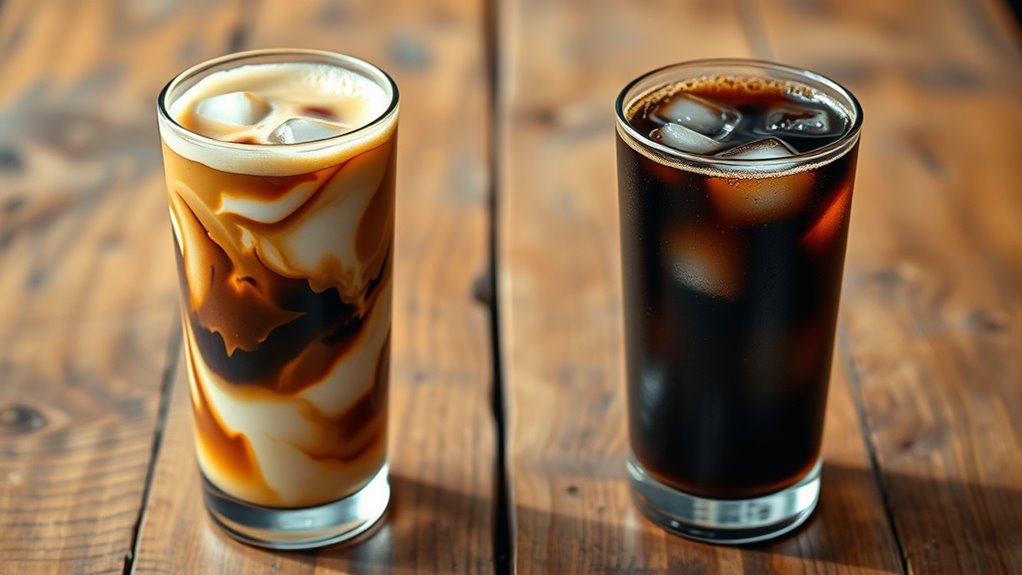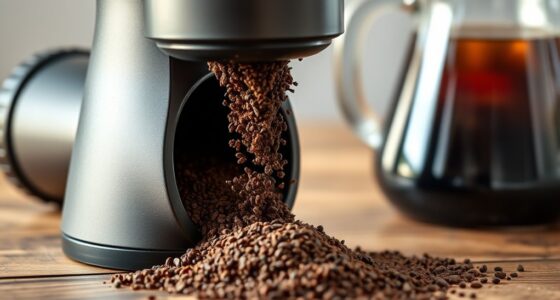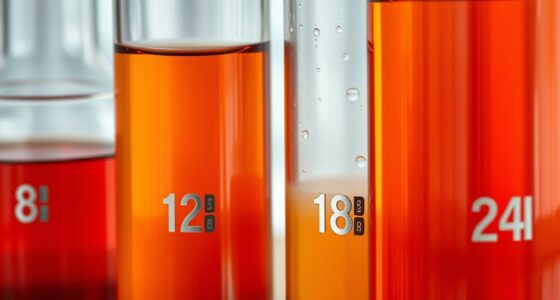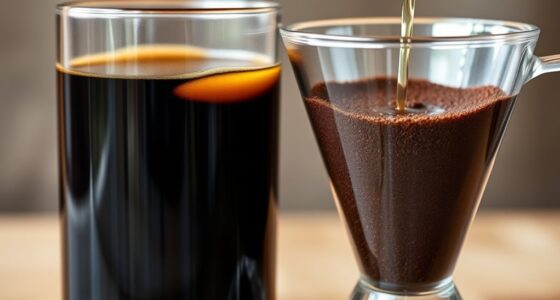Iced coffee is made by brewing hot coffee and then chilling it, which brings out bright, acidic, and aromatic flavors, especially with beans from Central America or Africa. Cold brew uses cold water steeped over 12–24 hours, resulting in a smoother, less acidic, and often chocolatey taste with beans from Southeast Asia. The brewing methods and chemical extraction influence flavor and aroma—exploring these differences helps you craft your perfect summer coffee. Keep exploring to learn how these processes shape your favorite cold drink.
Key Takeaways
- Hot brewing extracts more acids and oils, resulting in a vibrant, tangy flavor, while cold brew yields a smoother, less acidic taste.
- Cold brew involves steeping coffee grounds in cold water for 12–24 hours, unlike hot brewing methods used for traditional iced coffee.
- Hot brewed iced coffee offers a bright, aromatic profile, whereas cold brew provides mellow, chocolatey, or nutty notes.
- Chemical differences in extraction influence flavor perception, with hot brewing emphasizing brightness and cold brew highlighting smoothness.
- Personal preference for vibrant versus mellow flavors guides the choice between hot-extracted iced coffee and cold brew.
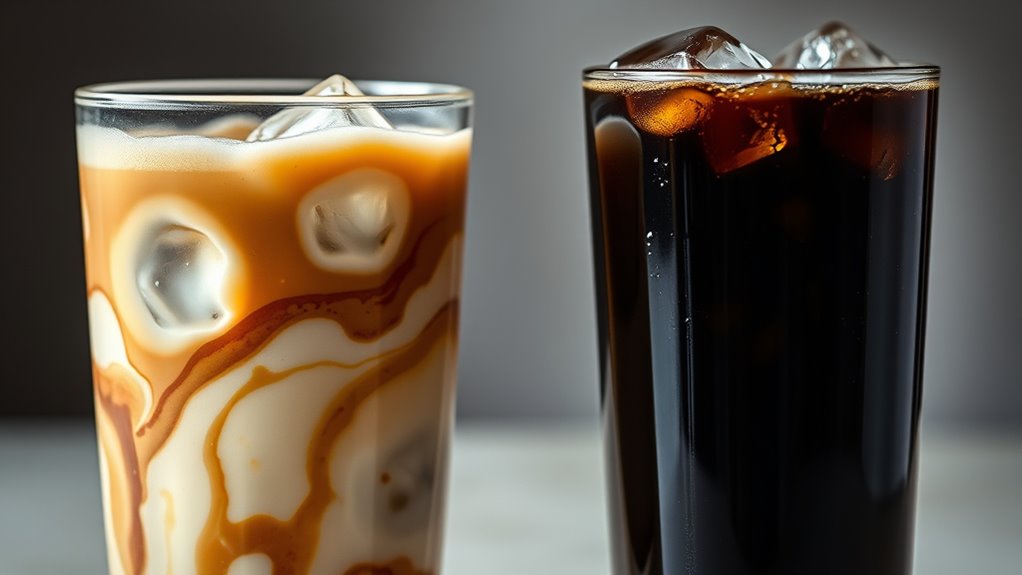
When it comes to revitalizing summer beverages, iced coffee and cold brew often stand out as popular choices. The differences between these two drinks go beyond just temperature; they hinge on how the coffee is made, the chemistry involved, and ultimately, the taste you experience. One key factor that influences the flavor profile is the coffee bean origin. Beans from different regions—whether they’re from Central America, Africa, or Southeast Asia—bring unique characteristics. Central American beans tend to be bright, with fruity or citrus notes, while African beans often have floral and berry undertones. Southeast Asian beans might offer earthier, spicier flavors. Choosing beans from specific origins can dramatically change your iced coffee or cold brew experience, making it more personalized and tailored to your palate.
Coffee bean origin shapes your iced coffee and cold brew, offering vibrant, fruity, floral, or earthy flavors tailored to your taste.
Another critical aspect that sets these beverages apart is the brewing temperature. For traditional iced coffee, hot brewing is common, involving steeping ground coffee at temperatures around 195–205°F (90–96°C). This high temperature extracts a broad spectrum of flavors quickly, resulting in a more robust, aromatic brew. Once brewed, you pour it over ice, which rapidly cools the coffee and dilutes it slightly but preserves the complex flavor profile. Cold brew, however, involves brewing with cold or room temperature water over an extended period—usually 12 to 24 hours. This slow extraction process occurs at or below room temperature, which means fewer bitter compounds are released. The lower brewing temperature results in a smoother, mellower flavor, often with chocolatey or nutty notes, depending on the beans used.
The chemistry behind these methods explains their flavor differences. Hot brewing extracts acids, oils, and other soluble compounds quickly, creating a vibrant but sometimes more acidic taste. Cold brew’s slow, cold extraction pulls fewer acids and bitter compounds, leading to a sweeter, less acidic coffee. This difference in chemical extraction is why cold brew tends to be smoother and less bitter, even if it’s concentrated. When you dilute cold brew to serve, it maintains a balanced, mellow profile, while iced coffee can sometimes taste sharper or brighter due to the hot extraction process. Additionally, the chemical composition of the coffee influences how these flavors are perceived and how they develop over time.
In the end, your preference depends on what you value most: the vibrant, aromatic qualities of hot-extracted coffee served cold or the smooth, mellow experience of cold brew. Understanding the influence of coffee bean origin and brewing temperature helps you appreciate the nuances and choose the ideal summer refreshment. Whether you lean toward the brisk, lively taste of iced coffee or the silky, subdued notes of cold brew, knowing these details lets you craft or select the perfect chilled coffee for your summer days.
Frequently Asked Questions
How Does Storage Affect the Flavor of Iced Coffee and Cold Brew?
Storage effects can markedly impact the flavor preservation of your iced coffee and cold brew. When you store them in airtight containers and keep them refrigerated, their flavors stay fresh longer. However, exposure to air, heat, or light causes oxidation, which dulls their taste and may introduce off-flavors. To enjoy the best flavor, drink your beverages within a few days and store them properly.
Are There Health Differences Between Iced Coffee and Cold Brew?
You might think cold brew is healthier than iced coffee, but both can offer health benefits like antioxidants. Cold brew is usually less acidic, which may be gentler on your stomach, and it often contains less sugar if you skip added sweeteners. However, watch out for high sugar content in flavored or pre-made versions. Overall, choosing unsweetened, black versions maximizes health benefits for both drinks.
Can You Make Cold Brew Using Instant Coffee?
Yes, you can make cold brew using instant coffee. Simply add your preferred amount of instant coffee to a jar or pitcher, then pour cold water over it. Stir well to dissolve the coffee completely. Let it steep in the refrigerator for about 12-24 hours, then strain or filter if needed. This quick brewing process produces a smooth, concentrated cold brew that’s ready to enjoy over ice.
What Are the Environmental Impacts of Each Brewing Method?
You’ll love this eco-challenge: cold brew uses more water, but often comes in sustainable packaging, making it a wash environmentally. Iced coffee requires hot water and energy for brewing, which adds to its footprint, yet it’s quicker and less wasteful. So, if you’re aiming for greener sips, consider how water usage and packaging choices balance out. Cheers to making your caffeine habit a little more planet-friendly!
How Does Caffeine Content Vary Between Iced Coffee and Cold Brew?
You’ll find that cold brew generally has a higher caffeine content than iced coffee because of the longer brewing time, which allows for more caffeine extraction. Iced coffee is brewed quickly with hot water, resulting in less caffeine per ounce. If you want a stronger caffeine kick, cold brew is your best bet, as its extended steeping process pulls more caffeine from the beans.
Conclusion
So, whether you prefer the quick, bright splash of iced coffee or the smooth, mellow richness of cold brew, there’s a perfect option for you. Don’t let the brewing time scare you—cold brew’s long steeping pays off with its unique flavor. Try both to discover your favorite; you might be surprised how each method offers a different, delightful experience. Immerse yourself and enjoy your customized coffee adventure—your taste buds will thank you!
